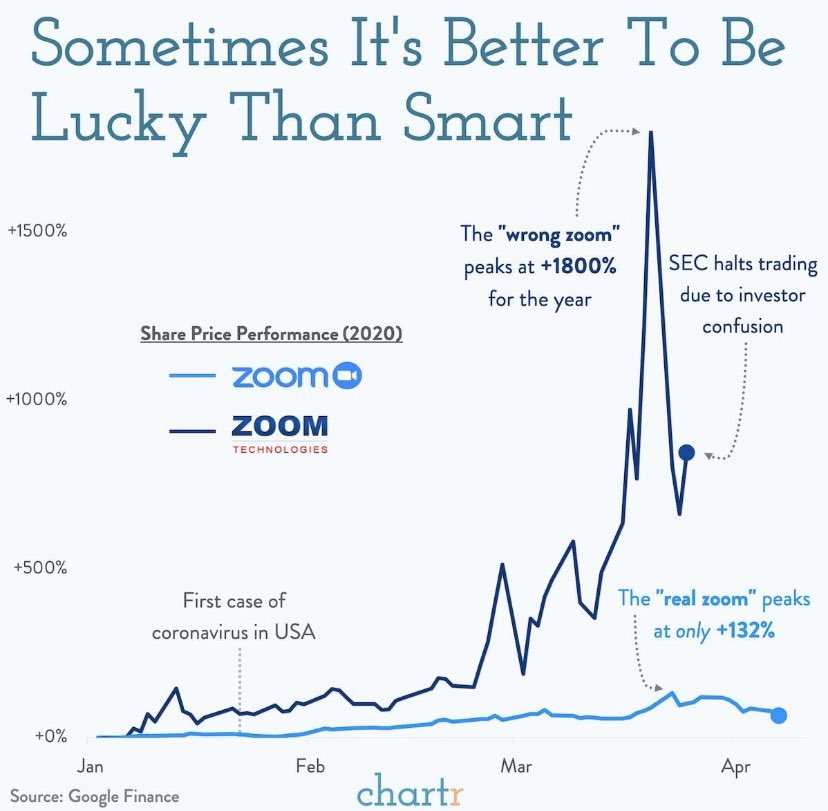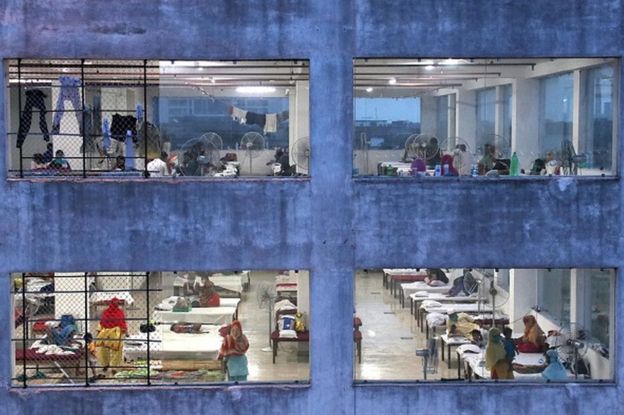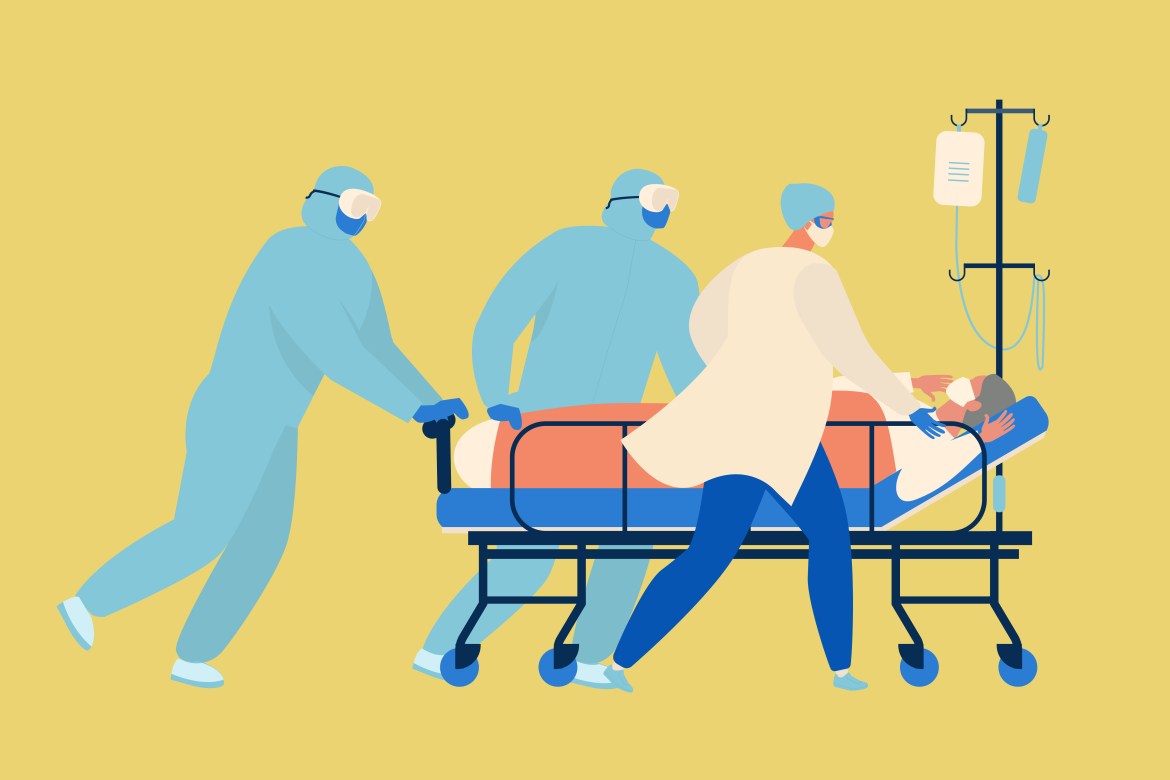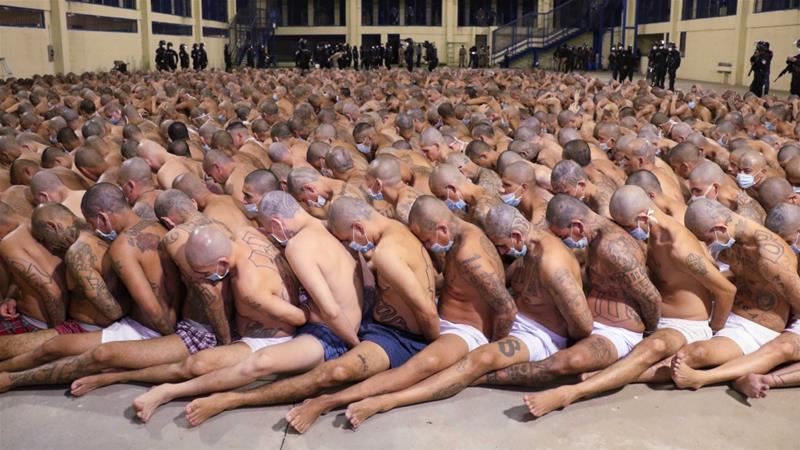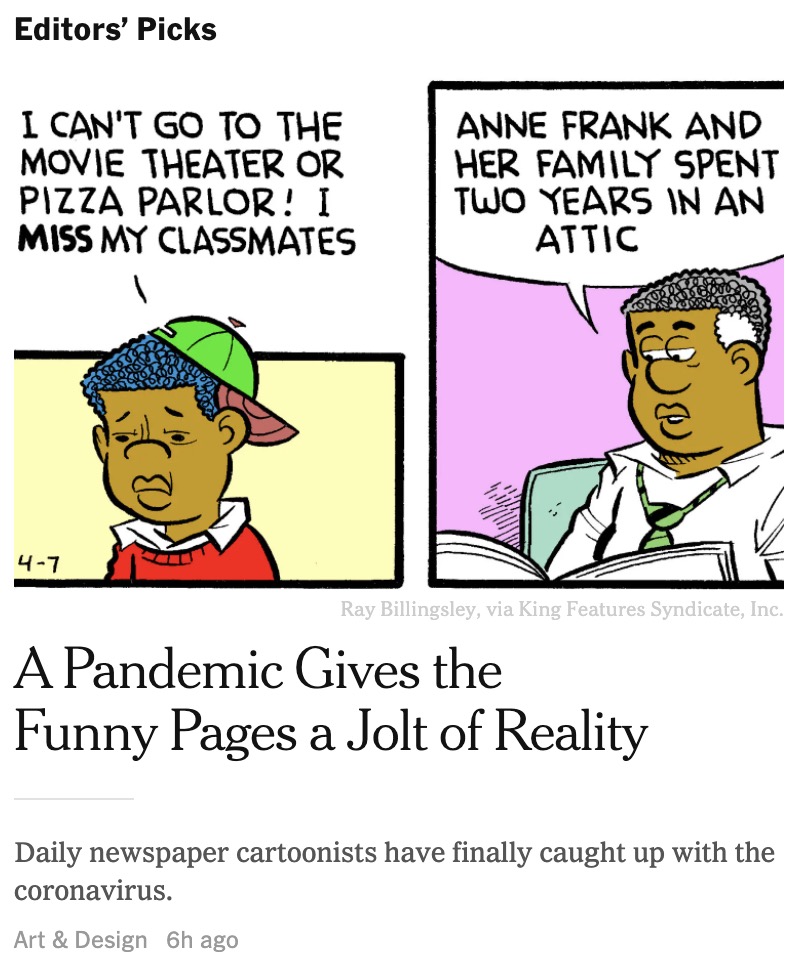"It's more urgent than ever."— QuickTake by Bloomberg (@QuickTake) April 28, 2020
We spoke with @AndrewYang about universal basic income in the era of #Covid19, and how he’d deliver stimulus checks if he were in charge #CoronavirusUSA pic.twitter.com/51jBukN6Z7
Trump insists he was being sarcastic but also that he was right. pic.twitter.com/Dw0OycGh7L— The Daily Show (@TheDailyShow) April 28, 2020
#RealStoriesOfPhysicians— Dr. Clair Cascella (@CascellaClair) April 27, 2020
I am a resident and we asked our program for PPE and were provided with 1 surgical mask/WEEK. When we protested, we were given 1 N95/MONTH. 4 of our residents have tested positive. The response from the PD was it was “our fault for not using proper PPE.”
I was asked in a town hall today if I supported a federal job guarantee.— Mike Broihier (@MikeForKY) April 26, 2020
My answer is no – here is why I support a #UBI instead:
A federal job guarantee implies that our worth is born from our labor.
A Universal Basic Income affirms our value and dignity as human beings.
Cautious return to normality needed https://t.co/lD0HjAK8T1— SCMP News (@SCMPNews) April 28, 2020
The president of the United States is a bigot rapist who suggested Americans inject bleach into their lungs, but hey at least he's not a woman who's too ambitious or a know-it-all!— Jessica Valenti (@JessicaValenti) April 28, 2020
The pandemic is a zoonotic virus spill-over from animals to humans, caused by unsustainable farming and trading wild-life and domestic animals in a globally networked world. Sustainability key to reduced future pandemic risks https://t.co/I9F9zNRiwl— Johan Rockström (@jrockstrom) April 28, 2020
Imagine believing in the efficient market hypothesis pic.twitter.com/kemFyirWdF— Vetle Forsland (@vetleforsland) April 27, 2020
What day is it, again?— CNN (@CNN) April 28, 2020
Our internal clocks are shot. Tuesdays are Thursdays are Wednesdays are Sundays. There are no weekdays, or weekends. There is only yesterday, today and tomorrow.https://t.co/ZtgdbSSUlY
"The EMTs were convinced it was a panic attack, not COVID-19. One of them sat with Mungin, who is Black, asking her questions to help her calm down. When he asked her about her long-term dreams and goals, she replied through labored breath, 'My goal is not to die today.'" https://t.co/eaEXPJydz8— Jenée (@jdesmondharris) April 27, 2020
— NDTV (@ndtv) April 28, 2020
Germany’s Coronavirus Cases Tick Up After Lockdown Restrictions Loosen Up https://t.co/3nw7qeTz8R pic.twitter.com/eNHFRfmgGg— Talking Points Memo (@TPM) April 28, 2020
COVID-19 is not a Chinese virus. It is a Global Warming virus.
Posted by Dan Duncan on Monday, April 27, 2020
The U.S. is 44th (per capita) in testing for #COVID-19. We are not #1.
Posted by Loren M. Jones on Monday, April 27, 2020
जनता समाजवादी : वैकल्पिक कि निर्णायक शक्ति?
कम्युनिस्ट भाइरसको दबदबा
माधव नेपाललाई फकाउने बालुवाटारको प्रयास असफल आइतबार नेपाल निवास कोटेश्वरमा अर्का अध्यक्ष पुष्पकमल दाहाल प्रचण्डसहित भएको नेपाल समूहको छलफलले पार्टी र सरकार दुवैतिर ओलीको नेतृत्व असफल भएकोले विकल्प खोज्नुपर्ने निश्कर्ष निकालेको थियो। ...... कोटेश्वरमा नेपाल र ओलीसमूहबीच छलफल चलिरहँदा खुमलटारमा प्रचण्ड, झलनाथ खनाल र वामदेव गौतमबीच छलफल भएको थियो।
जनकपुरमा पीसीआर परीक्षणमा 'नेगेटिभ' देखाएका रौतहटका दुई जनाको काठमाडौँमा परीक्षण गर्दा 'पोजेटिभ'
कोरोना संक्रमितको संख्या ५१ पुग्यो, दुई नयाँ संक्रमित थपिए
Donald Trump's immigration plans create panic and anger among the Indian diaspora in the US “I cannot tell you the panic this has caused in the legal immigration community,” Nandini Nair, an immigration lawyer based in New Jersey, said of Trump’s “upending of life by a tweet.” ....... Visa programmes like H-1B help fill specialty positions at companies like Google, Apple and Facebook. Indian-Americans are some of the country’s most successful and wealthiest immigrants, with a particular stronghold in Silicon Valley’s startup scene........ These days, Harkamal Singh Khural, 34, a software developer living in an Atlanta suburb, said he was barely sleeping. Even if the government did not push him out, he said a volatile job market meant his immigration status was already tenuous. ....... Most of the 800,000 immigrants currently waiting for a green card are Indian citizens. Because of quotas that limit the number of workers from each country, Indians can expect to wait up to 50 years for a green card since their representation among immigrants is so high in the United States........ Milan Vaishnav, the director of the South Asia Programme at the Carnegie Endowment for International Peace in Washington, said, “Any action that appears to infringe on the mobility of Indians or Indian-Americans will be strongly resisted.” ...... Over a video call, Nagar’s daughter, a kindergarten student, told her: “Mommy, when the virus dies, you’ll come. I’ll wait for the virus to die.” When video conversations with her daughter end, Nagar said she sometimes lies in bed and cries.
India coronavirus: The 'mystery' of low Covid-19 death rates They talk about the "mystery behind India's lower death rates" from the Covid-19 infection, and say that India is "bucking the coronavirus trend". One talks about the "Indian exception as death rates in major Indian cities are lower compared to global coronavirus hotspots". ........ Many public health professionals and doctors say India's grinding lockdown, which has lasted more than a month, could have kept infection and deaths in check. .........
the "lockdown is already having the desired effect of flattening the epidemic curve".
.......... doctors treating critical Covid-19 patients have told me that the contagion is as virulent here as has been reported elsewhere in the world. ........part of the mystery is we are not doing enough testing.
......... diagnostic tests which determine those who are currently infected and antibody tests to find out whether someone was previously infected and recovered. .......... Most affected countries have inadvertently under-reported deaths. ....... the death toll from coronavirus may be almost 60% higher than reported in official counts. ......... Around 80% of deaths in India still happen at home, including deaths from infections like malaria and pneumonia. Maternal deaths, and deaths from sudden coronary attacks and accidents are more often reported from hospitals. "A lot of people get some medical attention over time, return and die at home in India" ........... At the same time, there are no reports yet of a massive surge in hospital deaths, which would surely have not gone unnoticed .... a sharp spike in home deaths over a long period is also not likely to go unnoticed. ............ More than 850 million Indians use mobile phones and they could be persuaded to report any unusual death in their villages on a toll-free number. Authorities could then follow up the deaths by visiting the families and conducting "verbal autopsies"......Counting deaths has always been an inexact science in India........... only 22% of deaths in India are medically certified. ........ ....Some Indian doctors have reported that many people were dying of Covid-19 symptoms without getting tested or "treated". Then there's the question of wrong diagnosis in a country where doctors often misdiagnose the cause of death. ......... "But nobody is trying to hide deaths intentionally. You can't hide mass deaths"How Accurate Is the Coronavirus Death Toll? — A forensic pathologist's perspective ........... At an April 7 news conference, Deborah Birx, MD, the response coordinator for the White House coronavirus task force, said, "There are other countries that if you had a pre-existing condition and let's say the virus caused you to go to the ICU and then have a heart or kidney problem -- some countries are recording that as a heart issue or a kidney issue and not a COVID-19 death. Right now ... if someone dies with COVID-19 we are counting that as a COVID-19 death." ............
the tally of COVID-19 deaths in the United States and elsewhere in the world is almost certainly an undercount.
........ the overall numbers of deaths during the months of this pandemic have far outpaced the death rate during the same period in recent past years ............. Number one, COVID-19 can affect the heart (via myocarditis, pericarditis, or the formation of microthrombi). Number two, it's possible that the death may not have happened without the stress on medical resources caused by the pandemic. That's one of the reasons why the death toll in Italy is so bad -- their otherwise excellent healthcare system was grievously overloaded by a huge wave of COVID-19 patients. People who would've survived heart attacks during normal times died without medical intervention because they couldn't make it to the hospital or because the hospital couldn't treat them in time to save them. ........... after this pandemic terminates, an excellent approximation of the true fatality rate of COVID-19 deaths can be made by the calculation of the excess mortality for the period. .......... A soldier in the heat of battle can't think strategically about the outcome of the wider war. The death toll of COVID-19 is not going to be accurate until epidemiologists and statisticians have time to crunch the numbers. ..........We are slogging through a slow, brutal, worldwide mass-fatality event. Whatever the final tally, it will be a terrible one.
Yeap! Finland Will Become The First Country In The World To Get Rid Of All School Subjects By 2020, instead of classes in physics, math, literature, history or geography, Finland is going to introduce a different approach to life through education. Welcome to the phenomenon based learning! ....... “In Phenomenon Based Learning (PhenoBL) and teaching, holistic real-world phenomena provide the starting point for learning. The phenomena are studied as complete entities, in their real context, and the information and skills related to them are studied by crossing the boundaries between subjects.” ....... instead of learning physics (or any other subject) for the sake of learning it, the students will be given the opportunity to choose from phenomena from their real surroundings and the world, such as Media and Technology, or the European Union. ........ a student who wants to study a vocational course can take “cafeteria services” and the phenomenon will be studied through elements of maths, languages, writing and communication skills. Another example is the European Union, which would include economics, languages, geography and the history of the countries involved. ........... inquiry-based learning, problem-solution and project and portfolio learning. The last step is going to be practical implementation, being seen as the outcome of the whole process. .......
This reform is going to require a lot of cooperation between teachers of different subjects and this is why the teachers are already undergoing an intense training.
........ teachers who embrace this new teaching style will receive a small increase in their salary as a sign of recognition. ...... the interaction in this teaching style is something every teacher has always dreamed of. ......... A similar approach called the Playful Learning Centre is being used in the pre-school sector and it is going to serve as a starting point for the phenomenal-based learning.LA's Coronavirus Death Toll Climbs As SoCal Eases Restrictions As crowds packed beaches in Orange and Ventura counties, LA saw its COVID-19 death toll double in a week, including 11 health care workers.
Seniors With COVID-19 Show Unusual Symptoms, Doctors Say COVID-19 is typically signaled by three symptoms: a fever, an insistent cough and shortness of breath. But older adults — the age group most at risk of severe complications or death from this condition ― may have none of these characteristics. ......... Instead, seniors may seem “off” — not acting like themselves ― early on after being infected by the coronavirus. They may sleep more than usual or stop eating. They may seem unusually apathetic or confused, losing orientation to their surroundings. They may become dizzy and fall. Sometimes, seniors stop speaking or simply collapse. ...... At advanced ages, “someone’s immune response may be blunted and their ability to regulate temperature may be altered” ....... Recognizing danger signs is important: If early signs of COVID-19 are missed, seniors may deteriorate before getting needed care. ...... older adults who are profoundly disoriented and unable to speak and who appear at first to have suffered strokes....... “When we test them, we discover that what’s producing these changes is a central nervous system effect of coronavirus” .......... Included on the atypical list are changes in a patient’s usual status, delirium, falls, fatigue, lethargy, low blood pressure, painful swallowing, fainting, diarrhea, nausea, vomiting, abdominal pain and the loss of smell and taste. .......
How Will Coronavirus End? It Depends on Our Immunity. Three Possible Outcomes With the curve finally flattening in the US, the ramping up of anti-viral and vaccine trials against SARS-CoV-2—the virus that causes Covid-19—and the launch of antibody tests to screen for previous infection, it seems like science is rapidly moving towards the end game. How exactly the Covid-19 pandemic will finally bugger off into history is still anyone’s guess, but virologists and public health experts generally agree that immunity is key—either through widespread safe and effective vaccination, or when enough of our population has recovered from infections and gained herd immunity. ............ Like most processes in biology, immunity to SARS-CoV-2 is complex and mysterious, with results that could rapidly diverge into many possible futures. It’s partly why estimates of how long Covid-19 sticks around to wreak havoc can vary enormously, from months to years to…well, seasonal and forever, similar to the flu. ......... The immune system is basically an entire battalion of rapidly-adaptive units consisting of cellular scouts, killer cell assassins, antibody troops, and intelligence agents that log each encounter with a new enemy. When our body is assaulted by a new foe—viruses, bacteria, or even cancer—surveillance first kicks into high gear. ........ The complexity of our immune response is partly why a positive antibody test may not exactly mean you’re immune to Covid-19, and a negative antibody test doesn’t necessarily mean you’re not immune. ........... One study on the OG SARS virus that terrorized most of East Asia in 2003, for example, found that antibody levels dropped dramatically after three years from the initial infection. ......... the worst-case scenario: the cat-and-mouse seasonal battle. If the virus mutates fast and dramatically enough to outfox our immune system, then our bodies will no longer be able to quickly pick it out from an invader lineup. Our immune intelligence systems and battalions will once again have to fight off a new, if somewhat similar, enemy. It sounds like a frustrating scenario, but it’s exactly what happens with the flu every year. The flu virus mutates at a shockingly rapid rate, which means we’re always one step behind and the virus becomes a seasonal nuisance. The good news is not all viruses have the flu’s superpower. Preliminary studies find that SARS-CoV-2 seems to mutate at a much slower rate than the flu, which is great news for the sticking power of vaccines. .......
So how does the Covid-19 pandemic end? The uncomfortable truth is no one knows.
REPUBLICAN GROUP RELEASES AD DESCRIBING TRUMP AS 'UNFIT, UNWELL, UNACCEPTABLE'
The pandemic will leave the rich world deep in debt, and force some hard choices the fight against covid-19 has seen governments, particularly those in the rich world, rack up debts so large that the way in which they are paid off could have a long-lasting effect on their economies, and significantly affect the distribution of wealth. ............. Advanced economies will run an average deficit this year of 11% of gdp, according to the imf, even if the second half of the year sees no more lockdowns and a gradual recovery. Rich-world public debt could run to $66trn, which might be 122% of gdp by year’s end. ........... after the global financial crisis of 2007-09, which increased debt levels by about a third in advanced economies, many countries chose to reduce public spending as a share of the economy. Between 2010 and 2019 America and the euro zone cut their public-spending-to-gdp ratios by about 3.5 percentage points. Britain’s fell by 6 percentage points. Taxation, meanwhile, rose by between 1 and 2 percentage points of gdp. .......... The second option—defaulting or restructuring debts—may be forced on to emerging economies which lack any other way out. If it is, that will cause significant suffering. .......... choose to grow their way out of hock. The secret to this is ensuring that the economy’s combined level of real economic growth and inflation stays handily above the interest rate the government pays on its debt. That allows the debt-to-gdp ratio to shrink over time. ........ At its wartime height, America’s public debt was 112% of gdp, Britain’s 259%. By 1980 America’s debt-to-gdp ratio had fallen to 26% and Britain’s to 43%. ............ the coming years could prove to be politically demanding times. .......... inflation will surge of its own accord when the enormous economic stimulus they expect butts up against the supply disruptions imposed by lockdown. ........... Thanks in part to the Fed’s actions, the American government can borrow for ten years at an interest rate of just 0.6%. ......... bond-buying by central banks takes much of the worry out of some of the debt. ......... treating higher public debt as sustainable in a low-inflation, low-interest-rate world. .........
qe does not really neutralise public debt.
Central banks buy government bonds by creating new money which sits in the banking system in the form of reserves. And central banks pay interest on those reserves. Because the central bank is ultimately owned by the government, qe replaces one government debt-interest bill, interest payments on bonds, with another, interest payment on bank reserves. And although the latter are very low today—negative, in fact, in several places—they will stay so only so long as central banks do not need to raise rates to fight inflation. ............ The first sign of any debt trouble in the rich world would probably be rising inflation. ......... Steve Mnuchin, America’s treasury secretary, has said that on some days he has spoken to Jerome Powell, chairman of the Federal Reserve, more than 30 times. ............ Conveniently for politicians, some of the pain of high inflation would be borne by foreign investors, whose share of public debt exceeds 30% in many rich countries ........... A perception that a nominally independent central bank was in fact a creature of politicians would create a risk premium on investment that would slow growth throughout the economy. .......... Inflation would bring arbitrary redistributions of wealth to the disadvantage of the poor ........Wealth taxes, as favoured by Keynes back then and increasingly discussed by academics and left-wing politicians today, could find that their time had come.
Post-pandemic populations may welcome the sort of cost-free-to-most all-in-it-togetherness they might provide. Less radically, a value-added tax in America (which lacks one), higher taxes on land or inheritance, or new taxes on carbon emissions could be on the cards. .......... Even economists with reputations as fiscal hawks tend to support today’s emergency spending, and some want it enlarged. Yet one way or another, the bills will eventually come due. When they do, there may not be a painless way of settling them.Coronavirus News (59) https://t.co/p7D9RTsfhI #coronavirus #CoronavirusUSA #CoronavirusFacts #CoronaQuarantine #CoronavirusOutbreak #COVID19 #TrumpIsNotADoctor #LockdownIreland #pandemic #DonaldTrump #COVID #lockdown
— Paramendra Kumar Bhagat (@paramendra) April 28, 2020
This is "social distancing" in El Salvador's prisons. Appalling. Pressure is needed to keep the country from falling into a dictatorship. https://t.co/EtYWwpvKaa pic.twitter.com/sEktGdaDiJ
— Kenneth Roth (@KenRoth) April 28, 2020
Dr. Anthony Fauci says there needs to be a “productive partnership” between the federal government and states on testing. “The federal government has to provide strategic guidance as well as technical assistance.” https://t.co/Hdqielw81y
— CNN (@CNN) April 28, 2020
possibly the most boomer shit imaginable pic.twitter.com/jiYg0C4JYS
— frank furtschool (@osamabishounen) April 28, 2020
